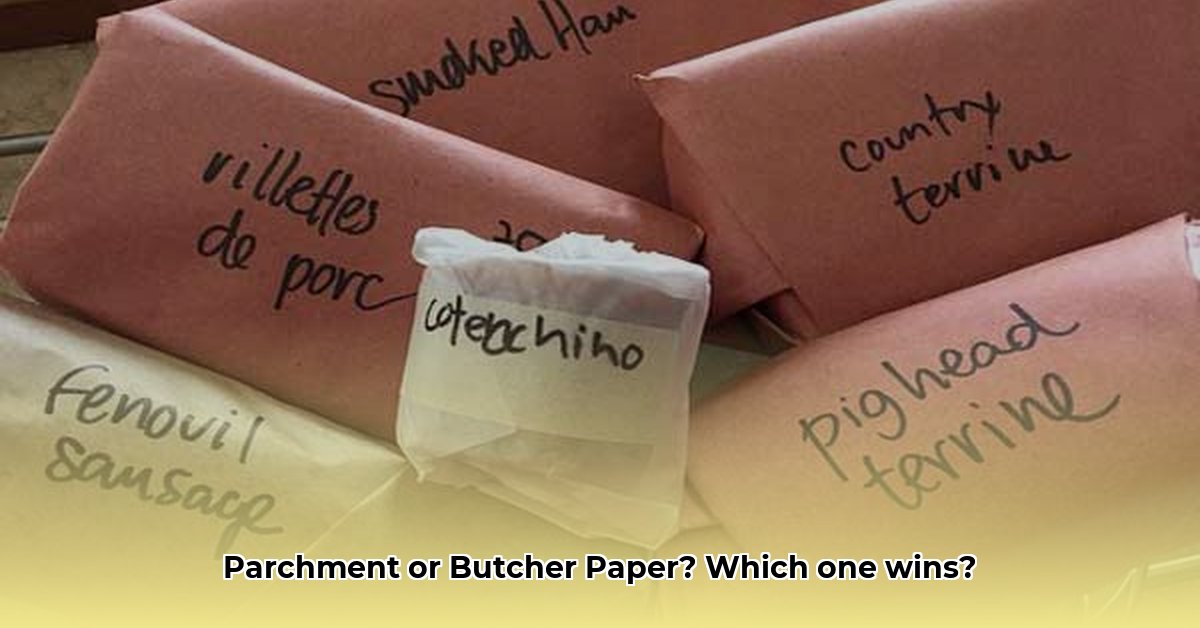Okay, picture this: You’re prepping for a backyard barbecue, ribs ready to smoke, cookies about to bake. You reach for some paper…but which one? Parchment or butcher paper? It’s a common kitchen conundrum, and we’re here to clear things up.
Quick Comparison
| Feature | Parchment Paper | Butcher Paper |
|---|---|---|
| Coating | Silicone | Typically Untreated |
| Thickness | Thin | Thick |
| Permeability | Low | High |
| Heat Resistance | High (up to 450°F/232°C) | Moderate (up to 450°F/232°C) |
| Best Uses | Baking, steaming, lining pans | Wrapping meat, smoking, grilling |
Decoding the Differences: Parchment vs. Butcher Paper
While both appear similar, parchment and butcher paper have distinct properties. Parchment, coated in silicone, is the non-stick champion, perfect for baking. Butcher paper, typically uncoated kraft paper, is more porous and absorbent, ideal for wrapping meats. The key differences lie in their coating, thickness, and how they react to heat.
Butcher Paper: The BBQ Essential
Butcher paper, made from kraft paper pulp, is a barbecue staple. Its breathability allows smoke to penetrate while wicking away excess moisture, contributing to that flavorful bark. This makes it perfect for the “Texas Crutch” – wrapping meat during smoking to help it push through the stall and achieve a tender, juicy interior. Its thickness also makes it suitable for wrapping and presenting food.
Parchment Paper: The Baking & Roasting Ace
Parchment paper, with its silicone coating, is a baker’s dream. Its non-stick surface prevents cookies from clinging to baking sheets, simplifies cleanup, and ensures cakes release from pans effortlessly. It’s also excellent for roasting vegetables, achieving crispy perfection and easy cleanup. Beyond these uses, parchment paper excels in en papillote cooking, steaming food in a sealed pouch to lock in flavor and moisture.
Practical Applications: When to Use Which
Smoking: The “Texas Crutch” and Beyond
The “Texas Crutch” highlights the parchment vs. butcher paper debate. While parchment’s moisture-trapping abilities can speed up cooking, some argue it hinders bark formation. Butcher paper, being more porous, allows some moisture to escape, potentially contributing to better bark. The choice depends on your priorities: a juicy interior or a crispier exterior. Some pitmasters even combine both, starting with butcher paper and finishing with foil for maximum moisture retention. For shorter smoking times or delicate items, parchment might be sufficient, but butcher paper is generally preferred. Ongoing research and BBQ community discussions continually refine best practices.
Baking/Roasting: Parchment Paper’s Domain
Parchment reigns supreme in baking. Its non-stick properties ensure effortless release and easy cleanup. It’s invaluable for cookies, cakes, pastries, and roasted vegetables. Butcher paper simply isn’t suitable for these applications.
Grilling/Wrapping: A Nuanced Approach
Butcher paper excels for wrapping larger items during indirect grilling or resting, locking in juices and adding a rustic touch. While parchment paper works for wrapping delicate items directly on the grill, it’s not ideal for high-heat applications due to the risk of melting or burning. For storing leftovers, both papers work, but butcher paper’s thickness adds durability.
Alternatives and Troubleshooting
While parchment and butcher paper cover most needs, alternatives exist. Aluminum foil works for grilling and wrapping but can impart a metallic taste. Silicone baking mats offer a reusable baking alternative but aren’t suitable for smoking. Wax paper is never suitable for high-heat applications due to its wax coating.
Troubleshooting
- Butcher paper tearing? Double wrap for extra security.
- Parchment paper browning? You’ve likely exceeded its temperature limit. Always check the package instructions.
Beyond the Basics
Sustainability
Research into the environmental impact of both papers is ongoing. Some studies suggest unbleached butcher paper may be slightly more sustainable, but more research is needed.
Pink Butcher Paper: Myth or Magic?
Some pitmasters believe pink butcher paper enhances bark formation, while others disagree. The debate continues, and experimenting is encouraged to see what you prefer.
Conclusion: The Right Paper for the Right Job
There’s no clear “winner” in the parchment vs. butcher paper debate. Parchment excels in baking and high-heat roasting, while butcher paper reigns supreme in smoking and wrapping. Consider your goals and choose accordingly. Need to wrap a sandwich? Butcher paper adds rustic charm. Storing leftovers? Butcher paper allows some air circulation, while parchment creates a tighter seal. Choose wisely, and your culinary game will thank you.
- Post 1 - October 30, 2025
- Enterprise Mobile App Development: How To Measure Room Temperature - October 14, 2025
- Google CBS Mobile App: Is CBS Charging Mobile Users? - October 13, 2025









